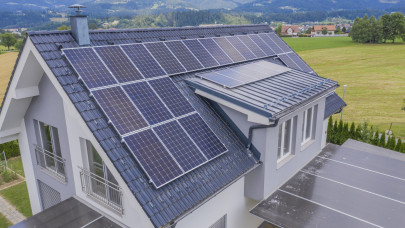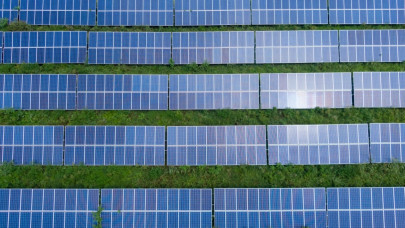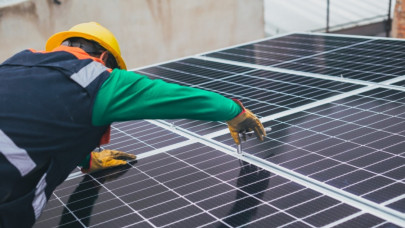The BASF Group's emissions reported under these targets in 2022 amounted to 18.4 million metric tons of CO2 equivalents (2021: 20.2 million metric tons). The increase in natural gas prices in Europe due to the war in Ukraine, weaker demand due to a slowing economy over the course of the year, and several lockdowns in China led to a significant reduction in production volumes and, as a result, emissions in 2022. This particularly affected the emissions-intensive ammonia value chain. The share of electricity from renewable sources was kept roughly constant compared with the previous year and, together with measures to increase energy and process efficiency, made a relevant contribution to reducing emissions.
The group's total energy consumption was 52.9 million MWh in 2022 (2021: 58.8 million MWh), significantly below the prior-year figure due to the lower production levels. Total energy consumption includes fuel demand in its own central power and steam generation plants, primary energy requirements in the process plants, and net power and steam imports.
In 2022, the group covered more than 54% of its electricity demand with its own gas and steam turbines in highly efficient combined heat and power plants. Combined heat and power generation reduces the carbon footprint of the group energy production and simultaneously ensures that fuels are used as efficiently as possible: For instance, compared with separate methods of generating steam and electricity, BASF saved 12 million MWh of fossil fuels and avoided 2.4 million metric tons of carbon emissions in 2022. In 2022, internally generated power in the BASF Group had a carbon footprint of around 0.25 metric tons of CO2 per MWh of electricity and was below the national grid factor at most BASF sites.
Total emissions of air pollutants from its production plants amounted to 23,360 metric tons in 2022 (2021: 25,869 metric tons). Emissions of heavy metals in 2022 amounted to 4 metric tons (2021: 2 metric tons).
”We want to further reduce emissions with various measures. For instance, we use catalysts to reduce nitrogen oxides or feed waste gases back into the production process”, according to the group's plan.
BASF generated 2.21 million metric tons of waste in 2022 (2021: 2.41 million metric tons). Of this, 52.6% were disposed of (2021: 52.4%). Hazardous waste accounted for 75.2% of the total disposed waste (2021: 76.9%).
”Based on the concept of the circular economy, we are continuously examining options for material or thermal recycling for all waste. In this way, we were able to find new uses for 47.4% of our waste in 2022 (2021: 47.6%). We continuously identify and evaluate the safest and most environmentally sound disposal routes for non-recyclable waste. In 2022, most of our hazardous waste was incinerated (75.1%), where possible with energy recovery. 8% of hazardous waste was disposed of in landfill. This was mainly contaminated construction waste that cannot be recycled due to legal requirements”, according to the report.
The goal is to introduce sustainable water management at the Verbund sites and at all production sites in water stress areas by 2030, covering 89% of BASF's total water abstraction. It achieved 61.6% of its target in 2022 (2021: 53.5%).1 Sustainable water management was introduced at seven further sites in 2022.
The water abstraction totaled 1,590 million cubic meters in 2022 (2021: 1,695). This demand was covered for the most part by freshwater such as rivers and lakes (86% of water abstraction). At some sites, BASF uses alternative sources such as treated municipal wastewater, brackish water, or seawater. A small part of the water the group uses reaches its sites as part of raw materials and steam or is released in its production processes.
The group abstracts most of the water it needs for cooling and production. In 2022, 5% of the total water demand was covered by third parties (2021: 5%). Water use in 2022 totaled 6,917 million cubic meters (2021: 7,110 million cubic meters).
”Put in relation to total water abstraction, this means that we use every liter we abstract around four times, or cover 79% of our water demand with reuse. We predominantly use water for cooling purposes (88% of water abstraction), after which we discharge it back to our supply sources with no product contact. We reduce our water abstraction for cooling purposes mainly by using recooling plants. Around 12% of our total water abstraction is used in production plants, for example, for extraction or dissolution processes or for cleaning. Here, too, we reduce our demand for water by recycling wastewater. Most of the water used for production purposes is discharged back to water bodies after being treated in our own or third-party wastewater treatment plants”, the group mentions.
The BASF Group's water consumption describes the amount of water that is not discharged to a water body, meaning that it is no longer available to other users. Consumption is mainly attributable to the evaporation of water in recirculating cooling systems. A smaller amount is from the water contained in its products. Water consumption in 2022 amounted to around 69 million cubic meters (2021: 72 million cubic meters). In 2022, around 25% of our production sites were located in water-stress areas (2021: 25%).
A total of 1,400 million cubic meters of water were discharged from BASF production sites in 2022 (2021: 1,503), including 163 million cubic meters of wastewater from production. Emissions of nitrogen to water amounted to 2,600 metric tons in 2022 (2021: 3,000). Around 10,600 metric tons of organic substances were emitted in wastewater (2021: 12,500). The wastewater 1 Aqueduct 3.0 was used to identify sites in water stress areas to determine pro-rata water abstraction and water consumption. contained 16 metric tons of heavy metals (2021: 17).
Phosphorus emissions amounted to 240 metric tons (2021: 340).
”Climate protection is very important to us and is an important part of our corporate strategy. We are pursuing ambitious climate protection targets, which we aim to achieve with comprehensive carbon management. This includes five levers to reduce our greenhouse gas emissions and demand for fossil fuels:
– Grey-to-green: We are increasingly meeting our electricity needs from renewable sources
– Power-to-steam: In the future, we will increasingly rely on electrical steam generation and in this way, also tap previously unused waste heat potential
– New technologies: We are developing completely new carbon-free and low-carbon processes and technologies for climate-smart chemistry
– Bio-based feedstocks: We are increasingly replacing fossil resources with alternative raw materials
– Continuous opex: Our operational excellence activities continually improve the energy and process efficiency of our plants”, according to the report.
The Corporate Strategy & Sustainability unit develops and tracks the BASF Group's climate targets and strategic levers for achieving them based on its corporate carbon footprint. The Net Zero Accelerator unit, which was established in early 2022, focuses on the accelerated implementation of existing and new cross-divisional projects to reduce emissions. The emphasis is on carbon-free and low-carbon production technologies, the circular economy (see page 43), and renewable energies.
In 2022, BASF invested €944 million in research and development in the Agricultural Solutions segment, which represents 9% of segment sales. Its well-filled innovation pipeline has a peak sales potential of more than €7.5 billion for products launched by 2032.
”The main focus here is sustainability, with four key areas: climate-smart farming, sustainable solutions, digital farming, and smart stewardship. We actively promote sustainability in the supply chain with our ambitious targets: By 2025, we aim to have conducted sustainability evaluations for 90% of the BASF Group's relevant spending. In addition, we aim to have 80% of suppliers improve their sustainability performance upon re-evaluation by 2025. In 2022, 85% of the relevant spending had been evaluated. Of the suppliers re-evaluated in 2022, 76% had improved. Both global targets are embedded in the target agreements of persons responsible for procurement”, says in the report.
BASF acquired raw materials, goods, and services for its own production worth approximately €54 billion in 2022. Of this, around 90% was procured locally. There were no substantial changes to its supplier structure.
In 2022, BASF purchased a total of around 35,000 different raw materials from more than 6,500 suppliers, and 1.2 million metric tons of renewable raw materials are purchased.
BASF is committed to responsible and sustainable global supply chains for other mineral raw materials. These include cobalt, a key component in the production of battery materials. The group's goal is to not purchase cobalt from artisanal mines as long as responsible labor and social and environmental standards cannot be verified.
In the BASF Group in 2022, 115 environmental and safety audits were conducted at 73 sites (2021: 143 audits at 71 sites). The sites were audited based on their individual risk profile. Auditing of the sites acquired from Solvay started as planned in 2022 but will need to continue in 2023 due to local coronavirus restrictions
The group has more than 70,000 suppliers. New suppliers are selected and existing suppliers are evaluated not only on the basis of economic criteria but also ESG standards. A total of 79 raw materials supplier sites were audited on sustainability standards on our behalf in 2022. It received sustainability evaluations for 963 suppliers.
”Consequently, we require our suppliers to comply with the applicable laws in full and to adhere to internationally recognized environmental, social, and governance (ESG) standards. We also expect our suppliers to make an effort to enforce these standards at their suppliers. In addition, we ask our suppliers to support and comply with our Supplier Code of Conduct – or to demonstrate and ensure their commitment to the principles specified in the Code of Conduct, for example in their own code of conduct”, says the report.
The BASF Group hired 10,893 new employees in 2022. As of December 31, 2022, the number of employees increased to 111,481 employees compared with 111,047 employees as of December 31, 2021. The rise was primarily due to staff increases in Asia Pacific, especially for the new Verbund site in Zhanjiang, China.
As of December 31, 2022, the BASF Group was training 3,049 people in 11 countries and around 50 occupations. The group spent a total of around €131 million on vocational training in 2022.
BASF set a global target to promote female leadership and aims to increase the proportion of women in leadership positions to 30% by 2030. In the BASF Group, the global proportion of female leaders with disciplinary responsibility was 27.2% at the end of 2022.
BASF Group expenses for societal engagement activities are about €30 million. In 2022, BASF also made donations to support people affected by the Russian attack on Ukraine. To this end, BASF initially provided €1 million in emergency aid to the German Red Cross in February 2022. In April, BASF additionally doubled the amount donated as part of the global employee fundraising campaign “#ColleaguesForUkraine” (€2,110,156 in total) to around €4.2 million. The donations benefited BASF employees from Ukraine through BASF Stiftung and Ukrainian refugees through the U.N. Refugee Agency.
BASF is a founding member of Together for Sustainability. The initiative was established in 2011 to improve sustainability in the supply chain. The focus is on the standardization, simplification, and mutual recognition of supplier audits and assessments.












